Quick start guide - LimeSurvey 2.50+: Difference between revisions
From LimeSurvey Manual
No edit summary |
No edit summary |
||
| Line 263: | Line 263: | ||
If you want to export the results in a different format in order to produce statistics and graphs using other apps such as SPSS, R, STATA, etc., access the survey you want to analyse. Click on the ''Responses'' button located on the top toolbar, and then on ''Responses & Statistics'': | If you want to export the results in a different format in order to produce statistics and graphs using other apps such as SPSS, R, STATA, etc., access the survey you want to analyse. Click on the ''Responses'' button located on the top toolbar, and then on ''Responses & Statistics'': | ||
<center>[[File:Quick start guide - Responses & statistics.png]]</center> | |||
<center>[[File:]]</center> | |||
Now you are on the '''Browse responses''' page. Look at the top toolbar for the '''Export''' button and select the desired format you wish to export to. If you select the first option, all the availalbe formats in which you can export the data will be displayed: | Now you are on the '''Browse responses''' page. Look at the top toolbar for the '''Export''' button and select the desired format you wish to export to. If you select the first option, all the availalbe formats in which you can export the data will be displayed: | ||
<center>[[File:Quick start guide - export function.png]]</center> | |||
<center>[[File:Quick start guide - Export different formats.png]]</center> | |||
Once the filters are set, click on the '''Export''' button located in the upper-right side of the window. | |||
=Other LimeSurvey features - advanced users= | =Other LimeSurvey features - advanced users= | ||
Revision as of 12:49, 25 September 2017
Introduction - what is LimeSurvey?
LimeSurvey is a free and open source online survey application written in PHP, and distributed under the GNU General Public License 2. The software enables users to develop and publish online surveys, collect responses, create statistics, and export the resulting data to other applications. You can either install LimeSurvey on your own server (LimeSurvey CE) or you can directly start utilizing it via one of our hosting services (LimeSurvey Pro).
The following start guide relies on the usage of LimeSurvey Pro. To install LimeSurvey on your own server, check our installation section from our manual.
Create a free LimeSurvey account
LimeSurvey allows every user to create a free account in order to test its features and core functions. To try it out, hover the mouse over Editions & Pricing that is located on the top toolbar of [LimeSurvey website]) and look for the Editions & Pricing button located under the LimeSurvey Pro option.

Four options will emerge: free, basic, expert, and enterprise. Click on the Register Now from the FREE option box:
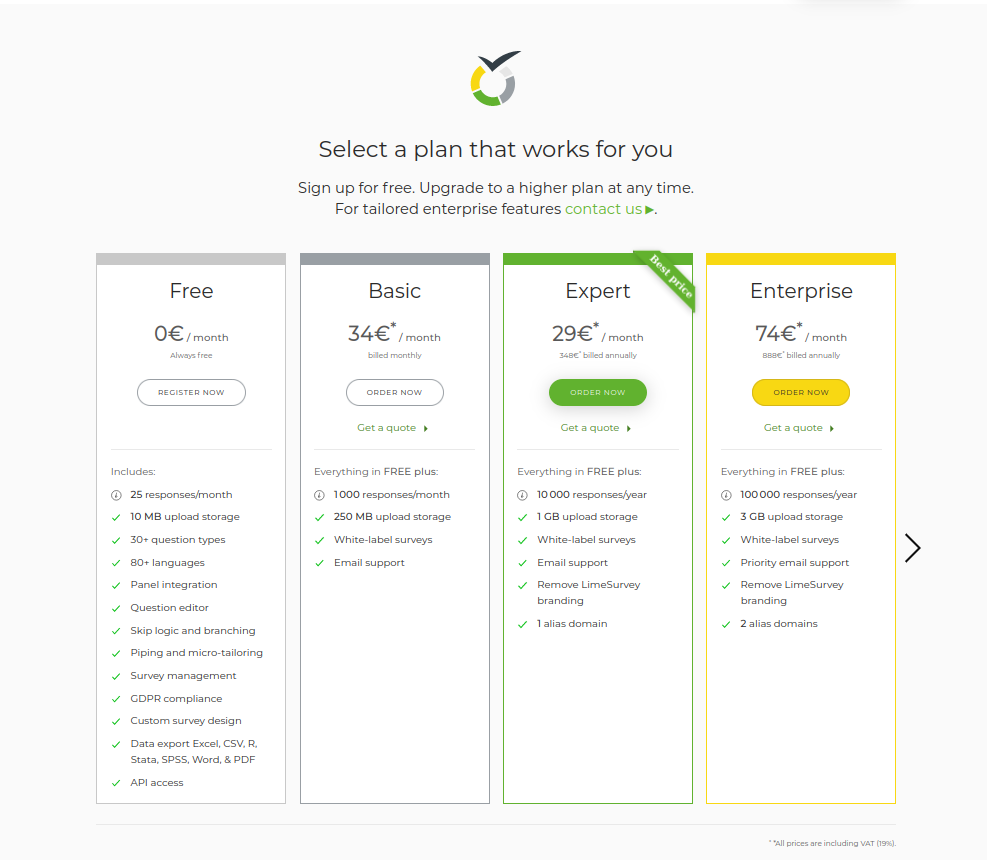
The next step includes filling in the following fields:
- Username: the username of your account which will also be used to access your LimeSurvey installation;
- Email: the email where the activation link will be sent to;
- Password: the password of your account which will also be used to access your LimeSurvey installation.
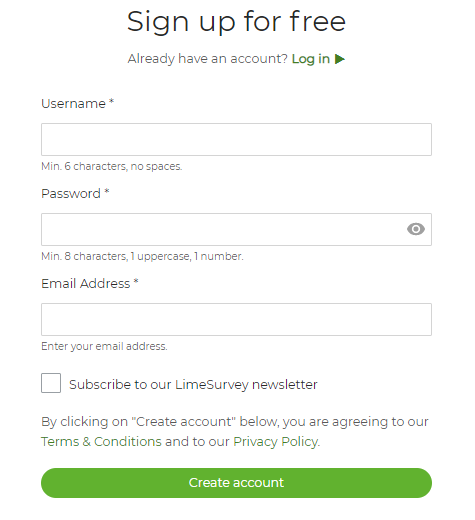
As you hover the mouse over each field, a text box will pop up with further details about each field. Optionally, you could also subscribe to the LimeSurvey newsletter in order to get help, tips & tricks, latest news, and service discounts.
For a faster registration process, LimeSurvey allows each user to sign up via their own Twitter, Gmail or GitHub account. LimeSurvey will gather the basic information we require from your selected source.
After creating your LimeSurvey account by clicking on the sign up button, you will receive an email from us. This email contains the activation link you should click on to access your newly created account. Once done, your account will become active and you will be automatically logged in to your LimeSurvey account.
To access your survey link, you have to first create an installation. Click on your username from the main toolbar, and then go to your LimeSurvey profile:

Select Installations from the Profile Menu located on the left side of the screen and create an installation:
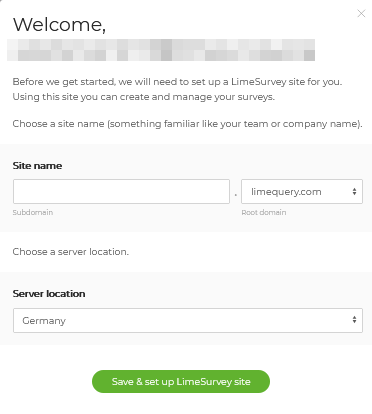
You will be asked to:
- type in the Domain name (the URL link of the questionnaire);
- choose the Server location – you can pick up one of the four server locations that will suit most of your needs.
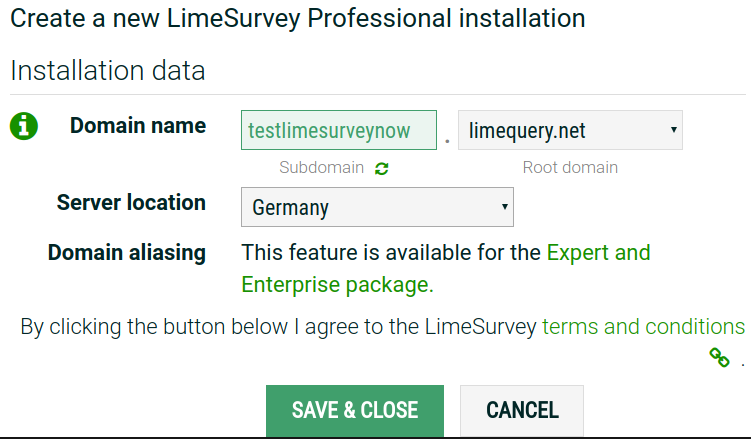
Once the domain-related fields are completed and saved, the installation process will start. This will take up to 10 seconds. After, LimeSurvey will display the settings of your installation:
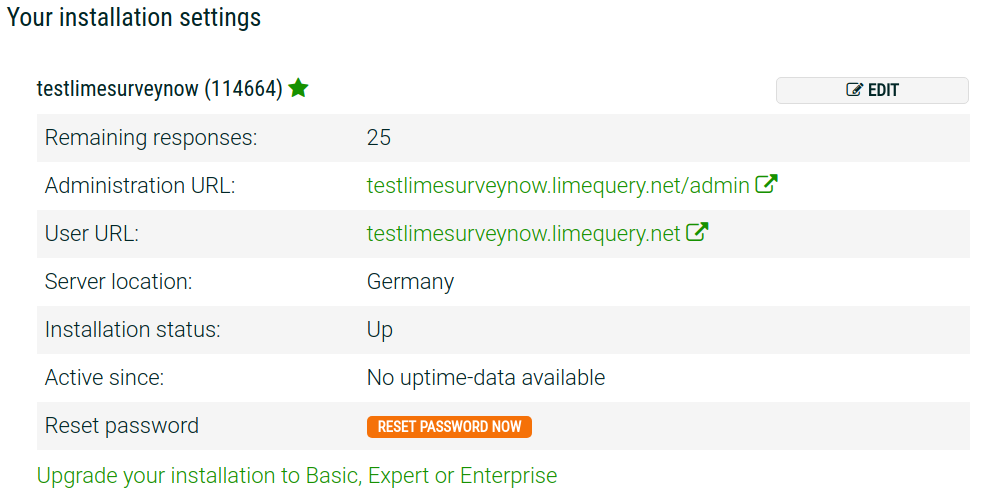
Now, you can access your server by clicking on the administration URL. To sign in to your LimeSurvey installation, use your LimeSurvey.org credentials.
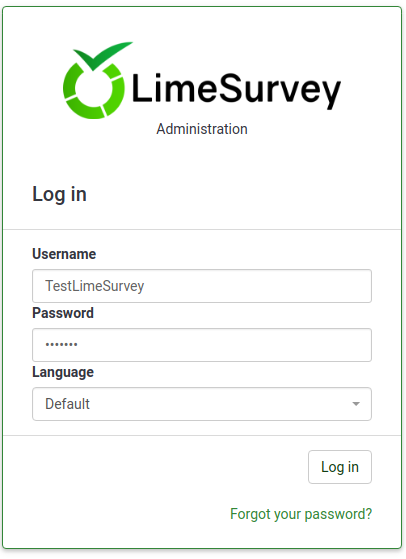
Start using LimeSurvey
Once logged in, you will find yourself on the home page of your LimeSurvey installation. It contains a toolbar located in the top-right part of the window and a default set of boxes at the center of the home page with some shortcuts.
The toolbar contains the following options:
- Configuration: Once selected, a dialog will show up from where you can administrate your LimeSurvey installation.
- Settings: Under this tab you may find options that can help customize your LimeSurvey installation.
- Home page settings: Users can use this option to tweak the settings of the home page according to their needs;
- Global settings: The changes done here affect the entire installation for all users;
- Plugin manager: It allows every user to activate a series of plugins that are supported by the LimeSurvey team. New plugins can also be added to your installation.
- Users: Under this tab you may find options related to the users and survey participants' management.
- Manage survey administrators: New administration users can be added from here;
- Create/edit user groups: This function is meant to group administration users in individual groups;
- Central participant database: It permits every administrator to store the participants' information to a central table that is independent of any token table.
- Advanced settings: It includes options that are non user or settings-related. They can be used to enhance your LimeSurvey installation.
- Template editor: If you would like to add/edit/delete templates, access this option. The templates allow control over the look and feel of pages of your survey;
- Manage label sets: Label sets are basically list templates where each list has a set of codes with labels and it can be used in most question types either as answers or as sub-questions;
- Check data integrity: it checks the consistency and the redundancy of the data.
- Backup entire database: Used to backup all your data in the case in which you would like to do an important LimeSurvey upgrade or move your LimeSurvey installation to another server.
- ComfortUpdate: It is a tool utilized to update your LimeSurvey installation easily from your web browser with just a few mouse clicks (instead of performing a manual LimeSurvey reinstallation).
- Settings: Under this tab you may find options that can help customize your LimeSurvey installation.
- Surveys: A survey includes via different interconnected databases: languages, question groups, questions, question attributes, answers, subquestions, default answers, assessments, quotas, quota members, and quota language settings. By clicking on the green arrow, a window will shop up with the following options:
- Create a new survey: A new survey;
- Import a new survey: If you would like to import a survey to your survey lists, use this function:
- Copy a survey: It allows the user to quickly copy a survey. This will appear in the surveys list from where it can be edited;
- List surveys: Allows you to get an overview of all the existing surveys.
- Response balance: It shows the number of responses left from your subscription. Because we have created a free account, we get 25 responses per month. If you run out of responses, purchase more from the following link;
- Storage: it represents the amount of MBs that are at your disposal to store your surveys and answers.Because you created a free account, you get 10 MB storage space. If you would like to receive more storage space, choose one of the following options from here;
- Username: By clicking on it, you can either access your user user preferences or sign out from your account;
- Notifications: Different notification related to your LimeSurvey installation will be displayed here.
There are six default boxes on the home page of your LimeSurvey installation:
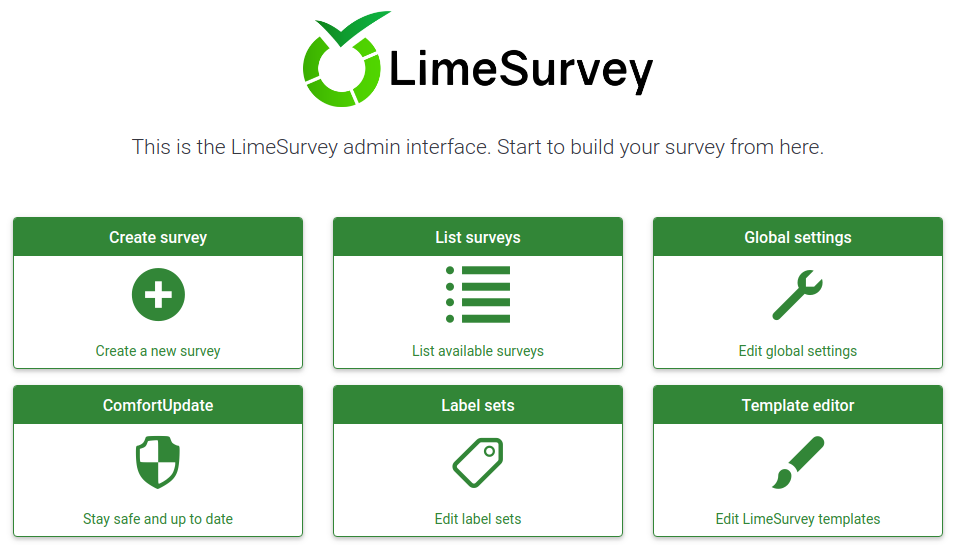
- Create a new survey
- List available surveys
- Edit global settings
- ComfortUpdate
- Label Sets
- Template editor
Create a survey
To create a survey group, click on the Create a new survey box:
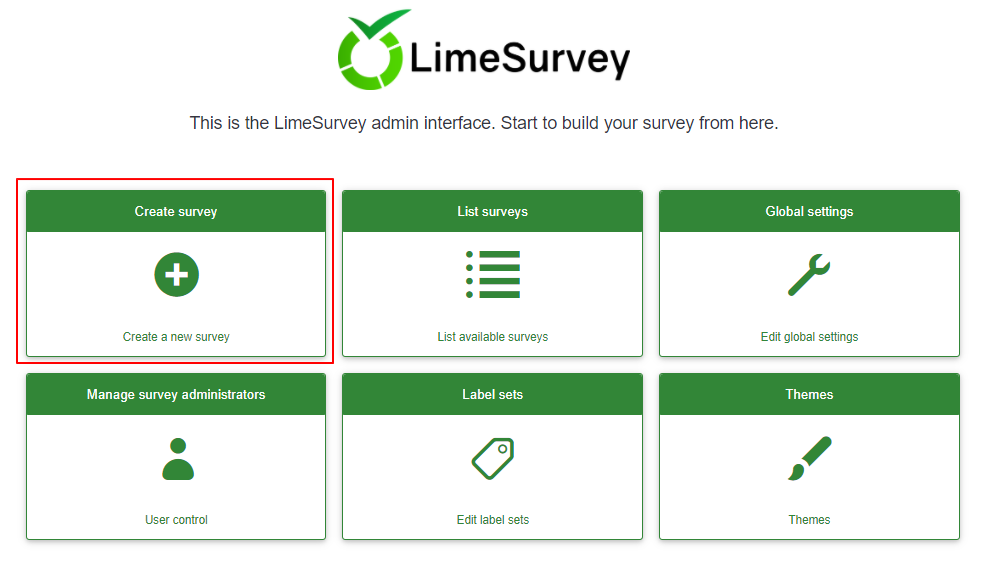
The Create survey page will be displayed:
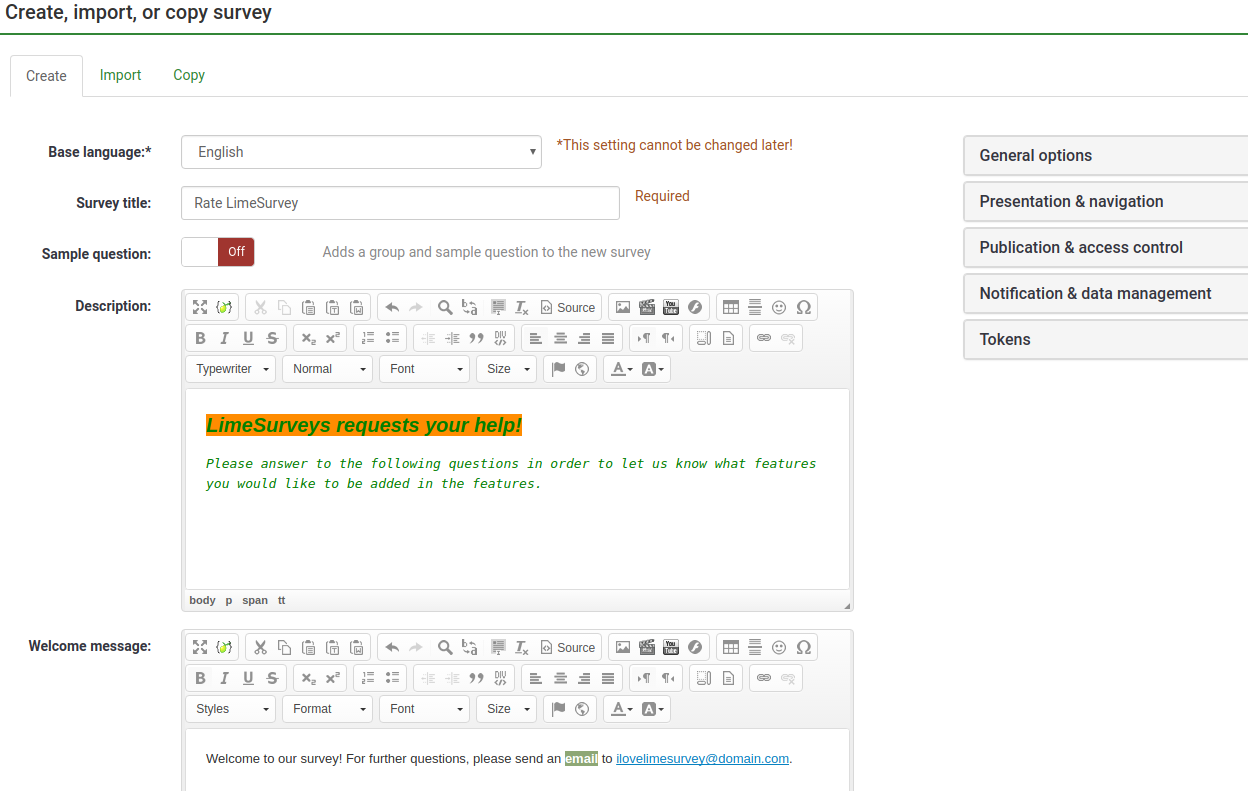
It contains the following information:
- Base language: The main language of the survey. Additional languages can be added later form the settings of the survey;
- Survey title: The title of the survey has to be typed here. It can be later changed;
- Sample question: It comes disabled by default. If you enable it, a question group and question examples will be added to your survey.
- Description: A short description of the survey can be added her;
- Welcome message: The survey participants will be prompted by this welcome message if something is typed in;
- End message: Type in a message that will be displayed to the survey participants once they finish the questionnaire.
Once you are done completing the fields, click on the Save and close button located in the upper-right part of the window. Once done, you will access the menu of the recently added survey:
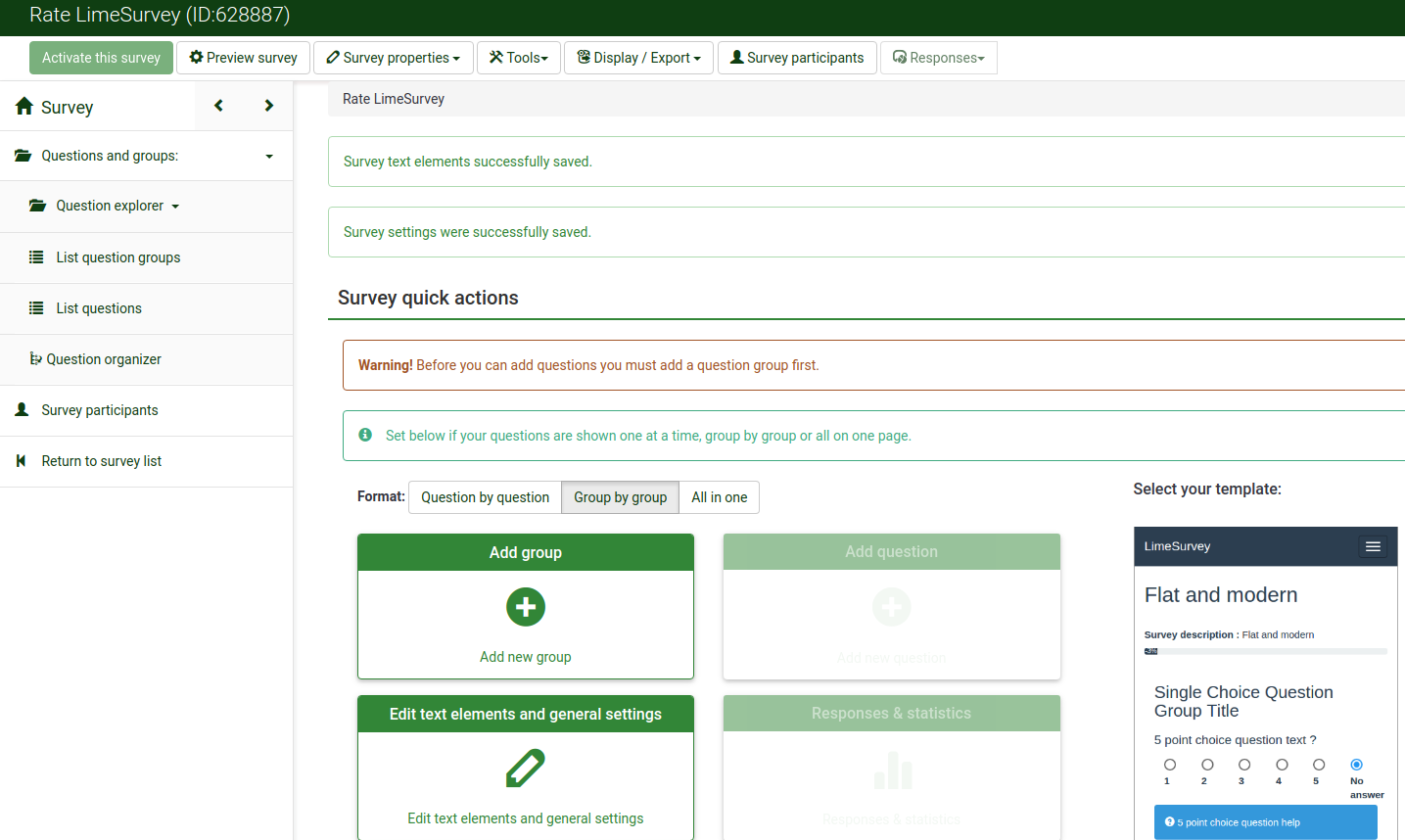
Create a question group
A question group is used to group different elements of a survey like descriptions, questions, and answers.
To create a question group, you have to first access the survey to which you want to add the question group. To do that, click on the Surveys button located on the toolbar from the LimeSurvey home page:
Click on the survey you wish to add the question group. The survey page will show up. Look for Add group button located on the left menu - Questions and groups -> Question explorer -> Add group:
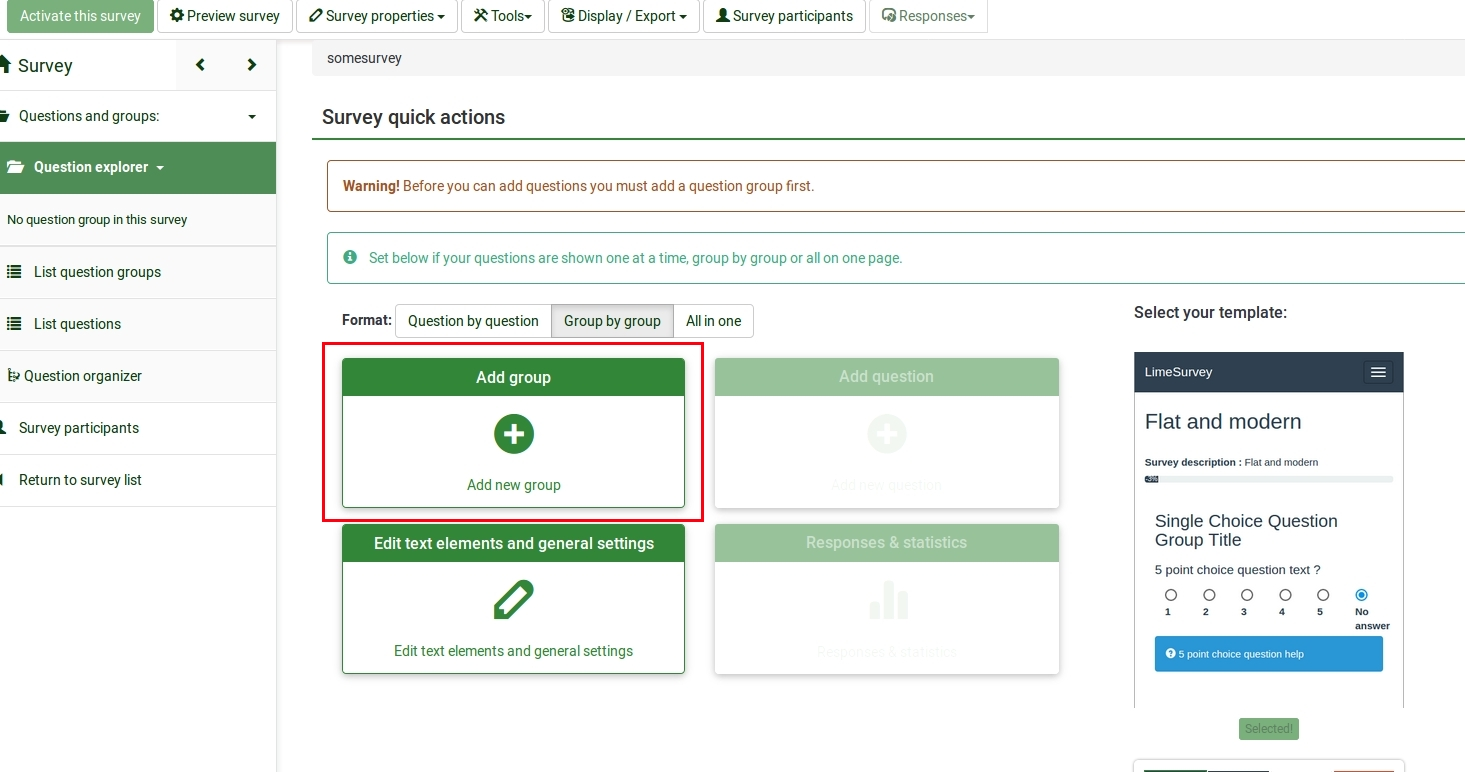
The following page will be displayed:
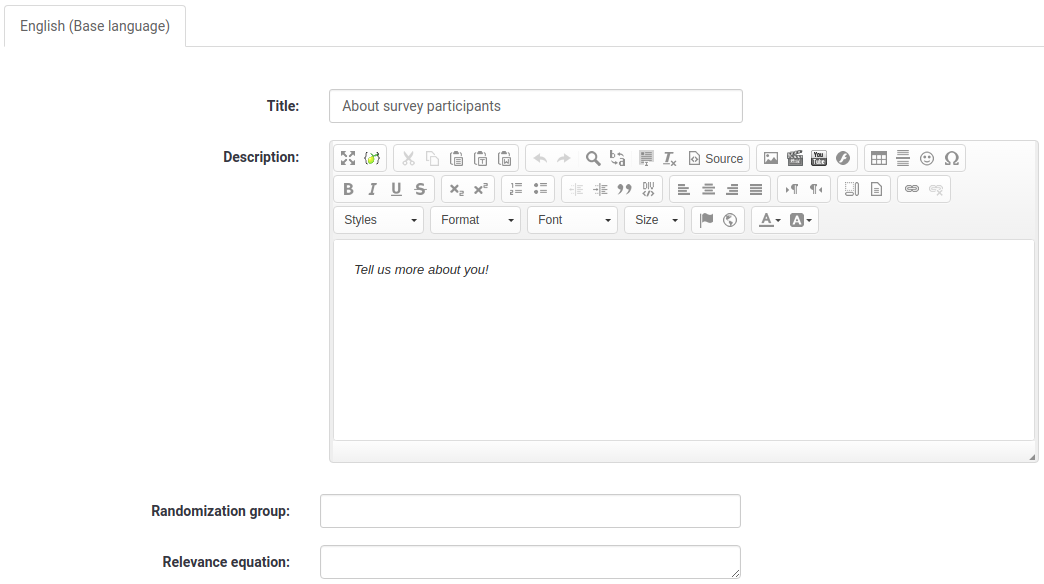
- Title: The name of the survey group;
- Description: A short description of the question group can be typed in. It can be shown to the suvey participants if this option is enabled from the survey settings;
- Randomization group: This function is used when you would like to randomize the question groups;
- Relevance equation: If used, the question groups displayed to the survey participants are If can be used to make survey participants answer to question groups depending on their prior answers. For more details, check our wiki on question groups.
Once done, click on the Save and close button located in the upper-right part of the window.
To see your recently added question group, go to the Survey menu and click on : Questions and groups -> List question groups:

Create a question
To create a new question, you need to first create a question group. Please check the steps presented above to see how you can add a question group to a survey. Once done creating the survey group, select the List question groups button from the survey menu:

A list with the all the survey question groups will show up. Now, look in the last column. It shows you four buttons, representing the available question group actions:
- Add new question to group: It is used to start adding questions to the correspondent question group
- Edit group: It allows the user to edit the respective question group;
- Group summary: If clicked, a summary page of that question group will be displayed;
- Delete: One option to delete the question group is to click on the red trash button.
Click on the first button and start adding your question to the desired question group. The Create question page will load up. It contains the following options:

- Code: It represents the name/code with which the survey is saved in the database and can be used further in more complex and advanced types of questions;
- Question:" The name of the question that will appear in the actual survey for the survey participants;
- Help:" Help can be provided in order to help the survey participants better understand the question we addressed them;
- General options: The general options allow you to modify the most important question-related settings. It includes four options:
- Question type: Many question types can be used in LimeSurvey. To better understand them, hover the mouse over each option or read our wiki on questions;
- Question group: You can choose here to which question group you would like to add the question to;
- Validation: This feature is available on all free text type or numeric questions. You can use standard Regular Expressions in this field to validate the responses to the question, and if the responses don't validate against this expression, the user will be prompted to try again before they can progress.
- Mandatory: For all question types this setting allows you to require users to answer the question, before they can move on to the next question. For ranking question this means all items have to be ranked.
- Relevance equation: It is a setting for advanced users. It is recommended to use the default value of "1" (it means that the item will be always shown). For more details, visit our wiki on the expression manager;
- Advanced settings: The advanced question settings are different for each question type. Please consult the documentation for your particular question type.
Click on the save button. Once done, you will be redirected to a page that shows different information about the recently added question:
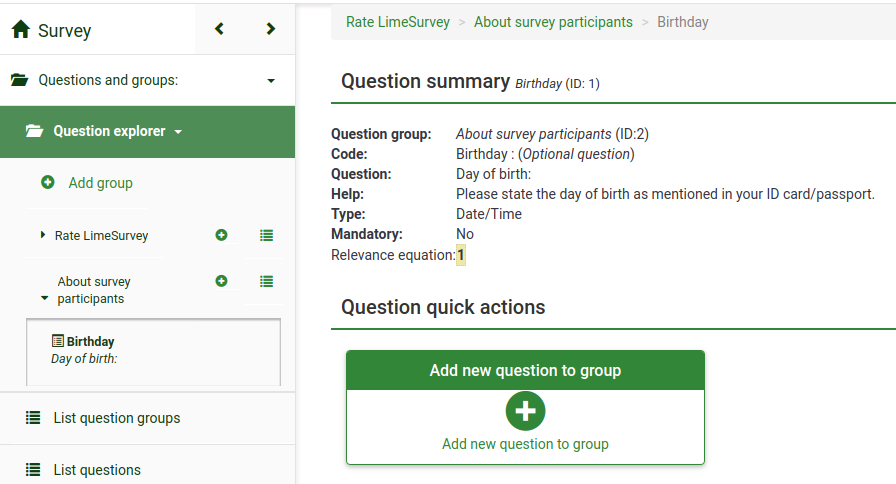
To add more questions, click on the Add new question button located in the Question quick actions menu.
Add subquestions and answers=
Different types of questions require subquestions, answers, both or none. For example, a question that requires the age of a survey participant does not require any subquestions or answers to be added to it. On the other hand, a simple array question requires both subquestions and answers.
In this example we will use the example of an array question-type:

Add subquestions
To add subquestions, go to the top toolbar and click on Edit subquestions. Type in the subquestions you wish the survey participants to anwer to:

Add answers
To add answers to the question, go to the top toolbar and click on Edit answer options. Type in the answers you wish to be used in your question:

Now, save the answers and preview the question (look for the Preview question button located on the top toolbar)
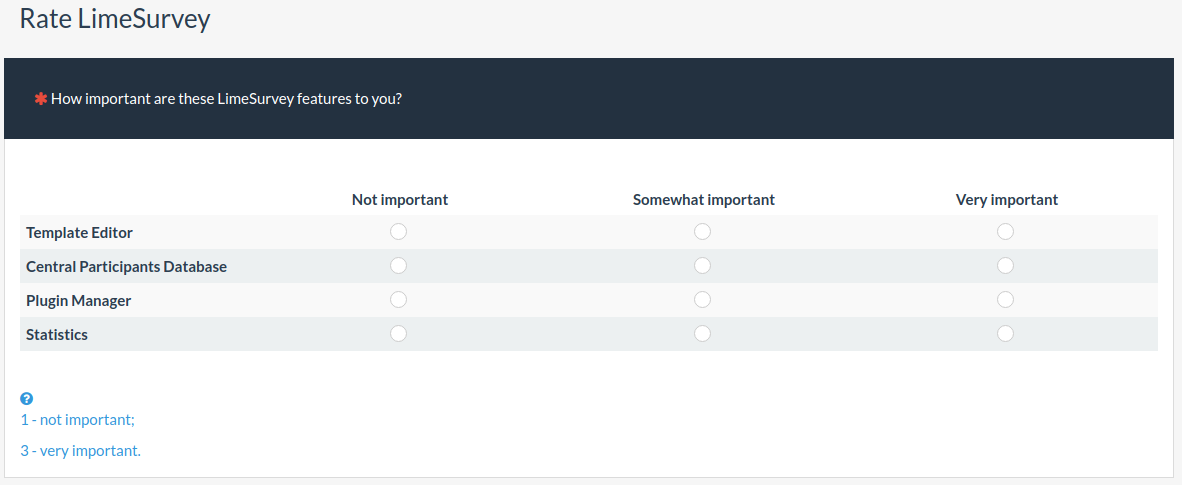
Congratulations! You have successfully created your first array-type question.
Organize questions
When you many questions in different question groups, it is a time-consuming to edit the type of each question one-by-one. Therefore, for a quick reorganization, use the Question organizer function (Survey menu -> Questions and groups -> Question organizer)
To reorder them, just drag the question/group with your mouse to the desired position. Do not forget to click on the Save button to save your changes.

Activate/Stop survey
Now that you have at least one question and question group added to your survey, you can activate it. Go to the home page of the survey by clicking on the Survey button, located on the top of the survey menu:

And the Activate this survey should be available on the top toolbar:
Before activation, a window will be displayed asking you about some general survey settings:

- Anonymyzed responses: This options allows you to determine whether responses to your survey are matched up with information from your surveys tokens table, or kept 'anonymous'. If you decide to enable it, then your survey is set to anonymize responses - there will be no way to connect answers and participants;
- Save IP address: If turned yes, the IP address of the survey respondent will be stored together with his or her answers;
- Save timings: If turned yes, the time spent on each page of the survey by each survey participant is recorded;
- Data stamp: Turn it on if you would like to see the time when the answers were submitted;
- Save referrer URL: If turned yes, the referrer URL will be stored together with the answers.
Once you finished selecting the desired options, click on the Save & activate survey button. The following message should be displayed:
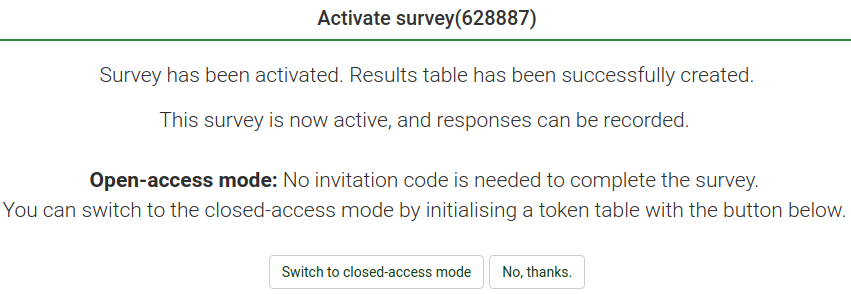
Select the option not to enable the closed-access mode! In this way, everyone will have access to your survey.
Congratulations! You have activated your first survey! If you want to start sharing the survey URL, go to the home page of your survey, and look for the survey URL in the Survey summary:

Copy the link and start sharing it.
If you want to stop the interview, access the home page of the survey and look for the Stop this survey button located on the top toolbar:

Statistics
To quickly see your survey statistics, click on the Survey button located on the top toolbar of your LimeSurvey home page. A list with all the available surveys will be displayed. Now, go to the last column and click on the Statistics button (![]() ) that corresponds to the row of your survey you wish to analyse:
) that corresponds to the row of your survey you wish to analyse:

A new window will load up with which contains simple charts. If you want to use them, scroll down and click on the Export images button located in the bottom-left part of the window. All the charts will be separately saved as .png files, archived in a .zip file.
In the top-right part of the window, you can observe the Expert mode button. Click on it in order to access advanced filters.
Once you select the filters according to which you want to analyse the data, click on the View Statistics button located on the upper-right part of the window.
[[File:]]
According to the chosen output, the results are displayed in HTML, Excel or PDF.
Exporting the questions and responses
If you want to export the results in a different format in order to produce statistics and graphs using other apps such as SPSS, R, STATA, etc., access the survey you want to analyse. Click on the Responses button located on the top toolbar, and then on Responses & Statistics:

Now you are on the Browse responses page. Look at the top toolbar for the Export button and select the desired format you wish to export to. If you select the first option, all the availalbe formats in which you can export the data will be displayed:

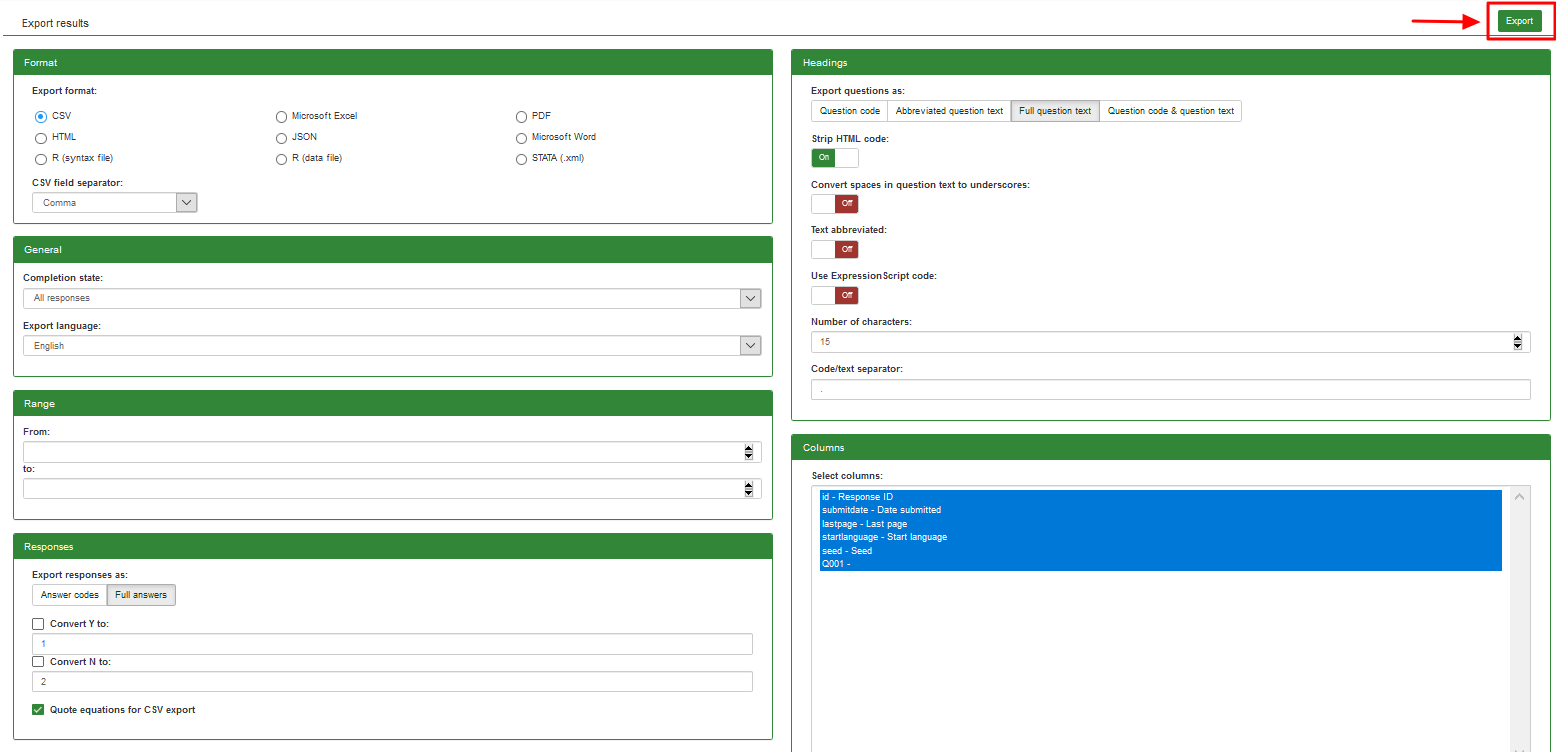
Once the filters are set, click on the Export button located in the upper-right side of the window.
Other LimeSurvey features - advanced users
Check the features of [LimeSurvey Pro] package by clicking on the following link: https://www.limesurvey.org/editions-and-prices/limesurvey-pro/professional-features.
If further questions arise, please post them on our forum or join the IRC channel.